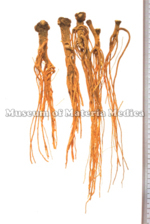Bupleurum Root

|
Market name:三島柴胡 Photo location:Museum of Materia Medica, Inst. of Nat. Med. TMPW No.:15455 |

|
Plant name:Bupleurum chinense or Bupleurum falcatum Photo location:Gansu Prov., China Photo date:2010 Photographer:K. Komatsu |
| Synonym | |
| Latin name | Bupleuri Radix |
| Botanical source: Family name | Umbelliferae |
| Botanical source: Plant name | Bupleurum falcatum Linné (IPNI:839147-1) |
| Part used | Root or whole plant |
| Empirical criteria for quality selection | The large roots which are moist and have less fragments of subterranean stems or leaves are good quality. (TN) |
| Constituents | Fatty acids: Stearic acid, Oleic acid, Linolic acid, Linolenic acid Sugar: Adonitol Triterpenoids: Saikogenin E, Saikogenin F, Saikogenin G; B. falcatum: Prosaikogenin F, Prosaikogenin G, Prosaikogenin A, Prosaikogenin D, Saikogenin F, Saikogenin G, Saikogenin A, Saikogenin D, Saikogenin E Triterpenoid saponins: Saikosaponin a, Saikosaponin b, Saikosaponin c, Saikosaponin d, Saikosaponin e, Saikosaponin f; B. falcatum: Saikosaponin a, Saikosaponin d, Saikosaponin b1, Saikosaponin b2, Saikosaponin c Sterols: α-Spinasterol, Stigmasterol, ⊿7-Stigmastenol, ⊿22-Stigmastenol |
| Pharmacological effects | Crude saponin fraction: Suppression of central nervous system, analgesic, antitussive, antifebrile, antiinflammatory, inhibition of stress ulcer, diuresis. Saikogenin A: suppression of central nervous system, analgesic, antitussive, antifebrile, antiinflammatory. Methanol soluble and water soluble fractions: analgesic, antiulcer. Saikogenin A, D: antiinflammatory, enhancement of protein synthesis in the liver, increase of the amount of glycogen in the liver, suppression of the increase in concentration of cholesterol, triglycerol and phospholipids. |
| Indications | As an antifebrile, antidote, painkiller, and antiinflammatory drug, it is applied to treat discomfort in the hypochondrium, alternate chills and fever such as malaria, jaundice, chronic hepatitis, chronic nephritis, metabolism disorder. it is known as a main medicine for "Shaoyang" disease. |
| Diseases | Liver cirrhosis, Fever, Alternating cold and fever, Feeling of bitter in the mouth, Depression, Restlessness, Pain due to flatulence of hypochondrium, Irregular menstruation, Hematochezia due to proctoptosis, Descent of the uterus |
| Formulas | en'nenhangeto , ogibekkoto , otsujito , otsujitokyodaio , kairosan , kamikihito , kamigedokuto , kamishoyosan , kamishoyosankasenkyujio , keigairengyoto , keibohaidokusan , saikatsugekito , saikatsutokasenkyushin'i , saikanto , saikyohangeto , saikokaboshoto , saikokaryukotsuboreito , saikokikitsuto , saikokeishikankyoto , saikokeishito , saikoseikanto , saikosokanto , saishakurikkunshito , saisoin , saibokuto , saireito , shigyakusan , shosaikoto , shosaikotokakikyosekko , shoyosan , shimpito , jiinshihoto , jijintsujito , jumihaidokuto , jofuto , jingyokyokatsuto , jingyobofuto , seikiankaito , seinetsuhoketsuto , daisaikoto , daisaikotokyodaio , chikujountanto , hochuekkito , yokukankashakuyaku , yokukansan , yokukansankashakuyakuoren , yokukansankachimpihange |
| Meridian tropism | Pericardium, Liver, Triple energizer, Gall bladder |
| Property | Slightly cold |
| Flavor | Bitter |
| Classification in "Shen-non Ben-cao Jing" | Superior |
| TCM: Classification | Diaphoretics |
| TCM: Medicinal effects | To relieve fever, to sooth the liver, lift up yang-energy. Used for alternate chills and fever, malaria, hypochondriac pain, irregular menstruation, uterine prolapse, anal prolapse. |
| Remarks | Listed in the Japanese Pharmacopoeia 18th ed. |
| References | TN: T. Namba & Y. Tsuda ed., Outline of Pharmacognosy, a Textbook, 3rd ed., Nankodo Co., Ltd., Tokyo, 1998. |
DNA sequences of medicinal plants
| Gene Region | |||||||||||||||||||
| Nuclear | Chloroplast | Mitochondria | |||||||||||||||||
| Botanical source: Plant name | 5Ss | 18S | ITS1 | 5.8S | ITS2 | 26S | others | trnH-psbA | matK | trnK | trnK-rps16 | trnT-L | trnL | trnL-F | rbcL | rpoC1 | ndhF | others | |
|
|
|||||||||||||||||||
|
|
|||||||||||||||||||
